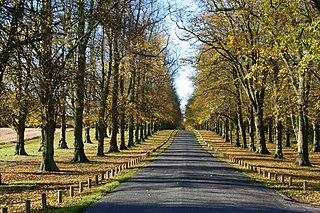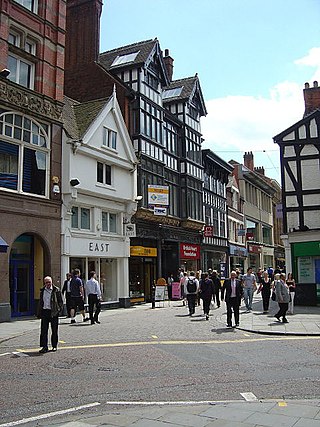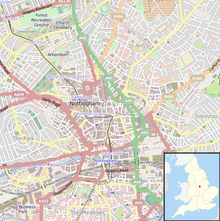
Clumber Park is a country park in The Dukeries near Worksop in the civil parish of Clumber and Hardwick, Nottinghamshire, England. The estate, which was the seat of the Pelham-Clintons, Dukes of Newcastle, was purchased by the National Trust in 1946. It is listed Grade I on the Register of Historic Parks and Gardens.

Attenborough is a village in the Borough of Broxtowe in Nottinghamshire, England. It forms part of the Greater Nottingham area and is 4+1⁄2 miles (7.2 km) to the south-west of the city of Nottingham, between Long Eaton and Beeston. It adjoins the suburbs of Toton to the west and Chilwell to the north. The population of the ward, as at the 2011 Census, was 2,328.

The Arboretum is a city park in Nottingham, England.

Bridlesmith Gate is a pedestrianised shopping street in the city centre of Nottingham, England. It is located between Middle Pavement and Victoria Street. St. Peter's Gate and Bottle Lane stem off it along with Byard Lane.

Watson Fothergill was a British architect who designed over 100 unique buildings in Nottingham in the East Midlands of England. His influences were mainly from the Gothic Revival and Old English vernacular architecture styles.
Thomas Cecil Howitt, OBE was a British provincial architect of the 20th Century. Howitt is chiefly remembered for designing prominent public buildings, such as the Council House and Processional Way in Nottingham, Baskerville House in Birmingham, Newport Civic Centre, and several Odeon cinemas. Howitt's chief architectural legacies are in his home city of Nottingham. He was Housing Architect for the City Council, designing municipal housing estates which are often considered to be among the finest in terms of planning in the country.

Thomas Chambers Hine was an architect based in Nottingham.
Richard Charles Sutton was an architect based in Nottingham. He was born 1834 and died on 18 October 1915.

High Pavement is a street in Nottingham in Nottinghamshire, England. It is one of the earliest streets in the city, and most of its buildings are listed.

Castle Gate Congregational Centre is in Nottingham. It is a Grade II listed building.

Captain Gilbert Smith Doughty CE was an architect based in Nottingham and Matlock.

Samuel Dutton Walker F.S.A. was an architect based in Nottingham.

John Howitt FRIBA was an architect based in Nottingham.

Castle Gate is an historic street near the centre of the English city of Nottingham. The street runs uphill, from a junction with Low Pavement, Lister Gate and Albert Street in the city centre, to Castle Road, near to the entrance to Nottingham Castle. The street is noted for its Georgian houses, many of which are listed buildings. There is also a complex of rock-cut caves, under buildings at the lower end of the street, which is a scheduled monument.

William Beedham Starr JP was an architect based in Nottingham.

John Collyer was an architect based in Nottingham.

Newdigate House is a Grade II* listed building on Castle Gate, Nottingham.

Thomas Simpson was an English architect based in Nottingham.

Captain Albert Edgar Eberlin FRIBA MC was an architect based in Nottingham.

19, Castle Gate, also known as Stanford House, is an 18th-century Grade II* listed building on the corner of Castle Gate and Stanford Street, in the English city of Nottingham. It should not be confused with 6, Stanford Street, a 19th-century grade II listed former warehouse, which is also known as Stanford House.



















